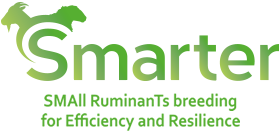
This project has received funding from the European Union’s Horizon 2020 research and innovation programme under grant agreement No 772787.
Validation and genetic analysis of a feed efficiency criterion in French Lacaune ewes
Some of the studies that have been submitted to WCGALP 2022:
– by C. Machefert, C. Robert-Granié, P. Hassoun, S. Parisot, C. Allain, D. Portes, G. Lagriffoul, J.M Astruc, and H. Larroque
Improving feed efficiency have environmental, economic and social benefits for dairy ewes farming systems. Selection of animals using efficiently their feed resources while maintaining a quality milk production is therefore a major objective for breeders. However, phenotyping feed efficiency remains difficult to achieve on-farm on a large scale. Indeed, it required individual performances as milk production and its components, body weight, body condition score and feed intake. The objective of our study was to propose a new criterion to approximate feed conversion ratio (FCR) of lactating ewes in a collective feeding context of commercial farms named lactation feed conversion ratio (LFCR). LFCR is the ratio between energy lactation requirements and energy inputs used to produce milk from feed and body reserves.
First, accuracy of this criterion was evaluated on experimental data (70 lactations of Lacaune ewes obtained in the European iSAGE project) with precise phenotypes including individual feed intake. The effect of replacing individual data with batch average data for each of the LFCR components could thus be evaluated. The lack of individual feed intake has the most impact on LFCR and can leads to reclassification of ewes. In this case, the coefficient of determination (R²) between the LFCRs, with or without individual data, was 0.37 and the root mean square error was 0.21. Then, the LFCR trait was applied to 6 test-days (TD) from 6425 lactations of Lacaune ewes from 8 production farms that were monitoring during two dairy years in the framework of Smarter project. In these conditions, this feed efficiency trait presented a low heritability (0.12 ±0.02) and a strong genetic correlation with the daily milk yield (0.80 ±0.03). Estimation of variance components for each TD showed that heritability and repeatability of this trait seemed to be lower at the beginning than at the end of lactation (Table 1).
Table 1. Heritabilities and repeatability of LFCR calculated at each test-day.
| TD 1 | TD 2 | TD 3 | TD4 | TD 5 | TD 6 | |
| Heritability (± SE) | 0.07
(± 0.02) |
0.11
(± 0.02) |
0.11
(± 0.02) |
0.12
(± 0.02) |
0.12
(± 0.03) |
0.20
(± 0.03) |
| Repeatability | 0.26 | 0.28 | 0.28 | 0.29 | 0.35 | 0.40 |
It has been shown that selecting a population on a ratio is difficult to implement because of the difficulty to predict the response to selection of ratio traits. However, our criterion can be measurable on commercial farms, and reflects an overall feed efficiency of ewe in a collective feeding context.

